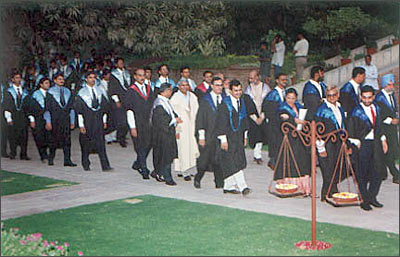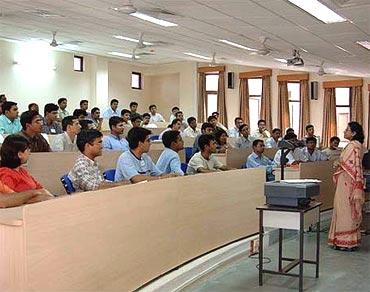Photographs: Rediff Archives Testfunda.com
The Symbiosis national aptitude test is conducted every year for entry into Symbiosis's 14 post-graduate management institutes across Pune, Nashik & Bengaluru. Symbiosis institutes are unique in their sector/ industry specific MBA offering.
Must know data
- The cut-offs for a call from SIBM is the highest -- 50 to 55 per cent of the total score, followed by SCMHRD and other 12 B-schools.
- Over the last 3 years, as almost all the sections have been on the easier side, the sectional cut-offs too have been on the higher side.
- Questions range from 120 to 150
- Each question has 4 options
- There is differential marking for Logical & Analytical Reasoning section and each of the other sections has had differential marking within itself in 2009
- 1/4th of the allotted marks get deducted for each incorrect answer
- No sectional time limit -- you can choose to allocate time to each section based on your comfort.
A snapshot of SNAP over the last 3 years
The table indicates that, across the years, the test has been on the easier side. Analytical & Logical reasoning section carries maximum weightage and is also the section which is very doable. It provides the maximum bang for the buck.


Tips to crack Symbiosis National Aptitude test
Change in approach
If IIFT three weeks ago was a test of accuracy, FMS a fortnight ago was a test of speed and JMET last week was again a test of accuracy, SNAP is a combination of both speed and accuracy.
As the questions are on the easier side and options can be eliminated quickly, it helps to solve more questions without trying to attempt any undoable question. There are enough easy to moderate questions in SNAP to help you clear the sectional and overall cut-offs.
The best approach to ace SNAP is to take 3 to 4 mock tests. TestFunda mocks are benchmarked on last two years' SNAP tests.
Sectional strategy
Verbal Communication
The emphasis on RC had gone down dramatically in 2009 -- there were only 3 questions. Even when RC accounted for 30 to 40 per cent of the General English section, the questions were pretty manageable and one could score well without spending too much time here.
The Vocabulary, Grammar and Usage based questions test your basic understanding of the rules of context, appropriateness and correctness. If you are good at basic English, even without knowing the rules of the formal language, you will be able to answer the required number of questions here.
Things to do right now
- Go through the basics of grammar and common errors in usage. Solve 5 questions on correct-incorrect sentences everyday.
- Solve 2 jumbled sentences and fill in the blank questions everyday.
- Go through the lessons on Idioms & phrases & word usage, & solve a couple of questions on an everyday basis.
During SNAP
- The number of words contained in the question and answer options is fewer -- very few long questions stems followed by fewer long & complex options. Thus, the number of words that you will need to read to answer a question and the data that you will need to analyse here is less compared to what it is in JMET, FMS or IIFT.
- You should be able to solve questions in this section very quickly. Deliberation on a particular question, if you don't get the answer quickly, can prove to be counter-productive.
Tips to crack Symbiosis National Aptitude test
Analytical & logical reasoning:
This section carries the maximum weightage in SNAP. In each of the last 3 years, 2 marks have been accorded to each of the 30 questions asked in this section.
A lot of case-lets and arrangement questions can be done in less time; although visual reasoning does make an appearance, the questions are pretty straightforward.
Things to do right now
- Practice different varieties of arrangement questions and case-lets. Download the FREE booklets on famous case-lets: Mental agility quizzes and puzzles on TestFunda.
- A good working knowledge of different types of syllogisms, implicit statements and arguments will help. Solve a few questions in each of these lessons before the day of test.
During SNAP
- You will increase your chances of improving your overall scores and ensuring a call by allocating more time to this section.
- The 2 mark questions do not expect you to give double the effort or time -- you can get more bang for the buck (time) spent here.
Tips to crack Symbiosis National Aptitude test
Quantitative ability, DI & DS
Quants & DI are clubbed in one section. DI is usually the easiest, followed by moderately easy questions from other topics. Quants has a good mix of questions across topics, hence you can choose to play on your strengths.
Things to do right now
- Browse through the lessons that you have practiced for different tests this year. There is no need to do anything different here. Although higher maths presents a few questions, almost all of them are doable.
- Solve a few questions in Quants and a case-let in DI everyday with added emphasis on speed.
- Like all other tests, revise important formulae. You can download a FREE e-book of 'the 50 most important formulae' at TestFunda.
During SNAP
Scan the section to shortlist questions that you are comfortable attempting. If you get stuck on a question or case-let which seemed easy earlier, it would be prudent to move on to the next one without wasting too much time on it.
Tips to crack Symbiosis National Aptitude test
General awareness
You will need to clear the cut-offs in this section to qualify for a call. Do remember that the cut-offs in this section are generally lower compared to the other 3 sections.
Things to do right now
- The section broadly covers questions from the 6 areas mentioned in the table above. Even if you are not very good at memorising data, it helps to get glued onto the happenings around the world. The idea is to go beyond headlines and look for insights, specific information, that most of the readers overlook.
- Get onto an online forum and discuss various topics in details.
During SNAP
This section should take the least amount of time -- you either know or don't know the answer. Deliberation on a particular question is really not going to help you arrive at the right answer as, sub-consciously, you may be worried about the time and number of questions remaining in the test.
Finally
SNAP tests every aspirant's ability to get the right balance of accuracy and speed. You not only will need to move fast across the sections but also ensure higher cut-offs as the overall test is on the easier side.
It is worth repeating that spending enough time consolidating your strengths and understanding your weaknesses by analysing every mock SNAP is not only desired but also necessary. Post every mock test, go through the detailed analysis report and identify your areas of high-low accuracy and speed. It will play a crucial role in helping you attempt or skip questions during the real test.
Even after spending reasonable amount of time on a question, if you realise you are not moving forward, it may be prudent to leave the question and move to the next one.
Good Luck and wish you all the very best to be a part of the Symbiosis family in 2011!






Comment
article